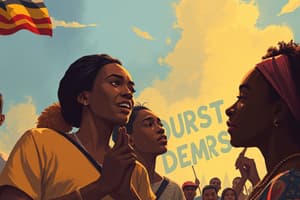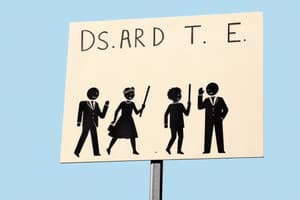Podcast
Questions and Answers
What was the primary goal of the Civil Rights Movement in the United States during the mid-20th century?
What was the primary goal of the Civil Rights Movement in the United States during the mid-20th century?
- Promoting economic development in urban areas
- Establishing a socialist government
- Achieving equal rights for all citizens, particularly African Americans (correct)
- Expanding U.S. territories
What is the primary purpose of affirmative action policies?
What is the primary purpose of affirmative action policies?
- To increase opportunities for historically marginalized groups (correct)
- To eliminate public transportation
- To promote violent protests
- To enforce segregation in schools
Which event marked a significant effort to end segregation in public schools?
Which event marked a significant effort to end segregation in public schools?
- Brown v. Board of Education ruling in 1954 (correct)
- The Civil Rights Act of 1964
- The Montgomery Bus Boycott
- The Freedom Rides
What was the strategy employed by Martin Luther King Jr. in the Civil Rights Movement?
What was the strategy employed by Martin Luther King Jr. in the Civil Rights Movement?
What were the Freedom Riders challenging with their actions in 1961?
What were the Freedom Riders challenging with their actions in 1961?
What distinguishes peaceful protests from militant protests?
What distinguishes peaceful protests from militant protests?
What does imposing liberalism typically involve?
What does imposing liberalism typically involve?
In an authoritarian political system, which of the following is true?
In an authoritarian political system, which of the following is true?
What is the main characteristic of a First Past the Post (FPTP) electoral system?
What is the main characteristic of a First Past the Post (FPTP) electoral system?
What defines a majority government?
What defines a majority government?
What is a key feature of a coalition government?
What is a key feature of a coalition government?
Which of the following best describes the concept of party solidarity?
Which of the following best describes the concept of party solidarity?
What role does a referendum play in democratic governance?
What role does a referendum play in democratic governance?
Which principle ensures that everyone is subject to the same laws in a democracy?
Which principle ensures that everyone is subject to the same laws in a democracy?
Which electoral system allocates seats based on the percentage of votes received by each party?
Which electoral system allocates seats based on the percentage of votes received by each party?
What is the main goal of interest groups in a democratic system?
What is the main goal of interest groups in a democratic system?
Flashcards
Representation by Population
Representation by Population
Seats in the government are distributed based on the size of the population in each area.
First Past the Post (FPTP)
First Past the Post (FPTP)
The candidate with the most votes in a region wins, even if they don't get a majority.
Proportional Representation
Proportional Representation
Parties get seats in the government based on the percentage of votes they receive.
Minority Government
Minority Government
Signup and view all the flashcards
Representative Democracy
Representative Democracy
Signup and view all the flashcards
Coalition Government
Coalition Government
Signup and view all the flashcards
Majority Government
Majority Government
Signup and view all the flashcards
Party Solidarity
Party Solidarity
Signup and view all the flashcards
Civil Rights Movement
Civil Rights Movement
Signup and view all the flashcards
Affirmative Action
Affirmative Action
Signup and view all the flashcards
Segregation
Segregation
Signup and view all the flashcards
Desegregation
Desegregation
Signup and view all the flashcards
Nonviolence Movement
Nonviolence Movement
Signup and view all the flashcards
Freedom Riders
Freedom Riders
Signup and view all the flashcards
Sit-In
Sit-In
Signup and view all the flashcards
Authoritarian Political System
Authoritarian Political System
Signup and view all the flashcards
Study Notes
Civil Rights Movement
- Focused on ending racial discrimination and achieving equal rights for African Americans in the mid-20th century US
- Affirmative Action: Policies to increase opportunities for historically marginalized groups, primarily in education and employment
- Segregation/Desegregation: Segregation involved the enforced separation of racial groups (e.g. in schools, transportation) while desegregation ended this separation, as seen after the Brown v. Board of Education ruling in 1954
- Nonviolent Movement: A strategy emphasizing peaceful protest and civil disobedience to oppose injustice
- Freedom Riders: Civil rights activists challenging bus segregation laws in the American South in 1961
- Sit-Ins: Nonviolent protests occupying spaces like lunch counters to challenge discriminatory policies
- Protests (Peaceful vs. Militant): Peaceful protests involved demonstrations like marches and sit-ins whereas militant tactics, sometimes involving confrontation or property damage, were also seen (e.g., the Black Panther Party)
Impositions of Liberalism
- Imposing liberalism involves promoting or enforcing liberal values (democracy, human rights, free markets) on other societies
- Example: The 2003 US intervention in Iraq, aiming to implement liberal democracy, is often cited.
- Criticism: Critics argue such impositions can lead to instability and cultural resistance
Political Vocabulary
- Authoritarian Systems: Power concentrated in a single leader or small group with limited political freedoms (e.g., North Korea)
- Direct Democracy: Citizens directly vote on laws and policies (e.g., ancient Athens)
- Representative Democracy: Citizens elect representatives to make decisions (e.g., Canada)
- Representation by Population: Government seats distributed based on population size (e.g., Canada's House of Commons)
- First Past the Post (FPTP): Electoral system where the candidate with the most votes wins, even if not a majority
- Proportional Representation: Electoral system allocating seats in proportion to votes received
- Minority Government: Government formed by a party with fewer than half of the seats, requiring coalitions
- Coalition Government: Government formed by multiple parties sharing power
- Majority Government: Government formed by a party holding more than half the seats in a legislative body
- Party Solidarity: Party members voting as a unified bloc
- Free Vote: Voters vote according to their personal beliefs, not party lines
- Referendum: Direct vote by citizens on a specific policy (e.g., Brexit)
- Consensus Decision Making: Group decision-making where all members agree
- Interest Group: Organized group seeking to influence government policy (e.g., labor unions, environmental organizations)
How Democracies Focus on Liberal Values
- Individual Rights: Protection of freedoms like speech, religion, and equality under the law
- Rule of Law: Everyone subject to the same laws, ensuring accountability
- Popular Sovereignty: Citizens hold ultimate authority through elections
- Economic Freedom: Support for free markets and private enterprise
Studying That Suits You
Use AI to generate personalized quizzes and flashcards to suit your learning preferences.




